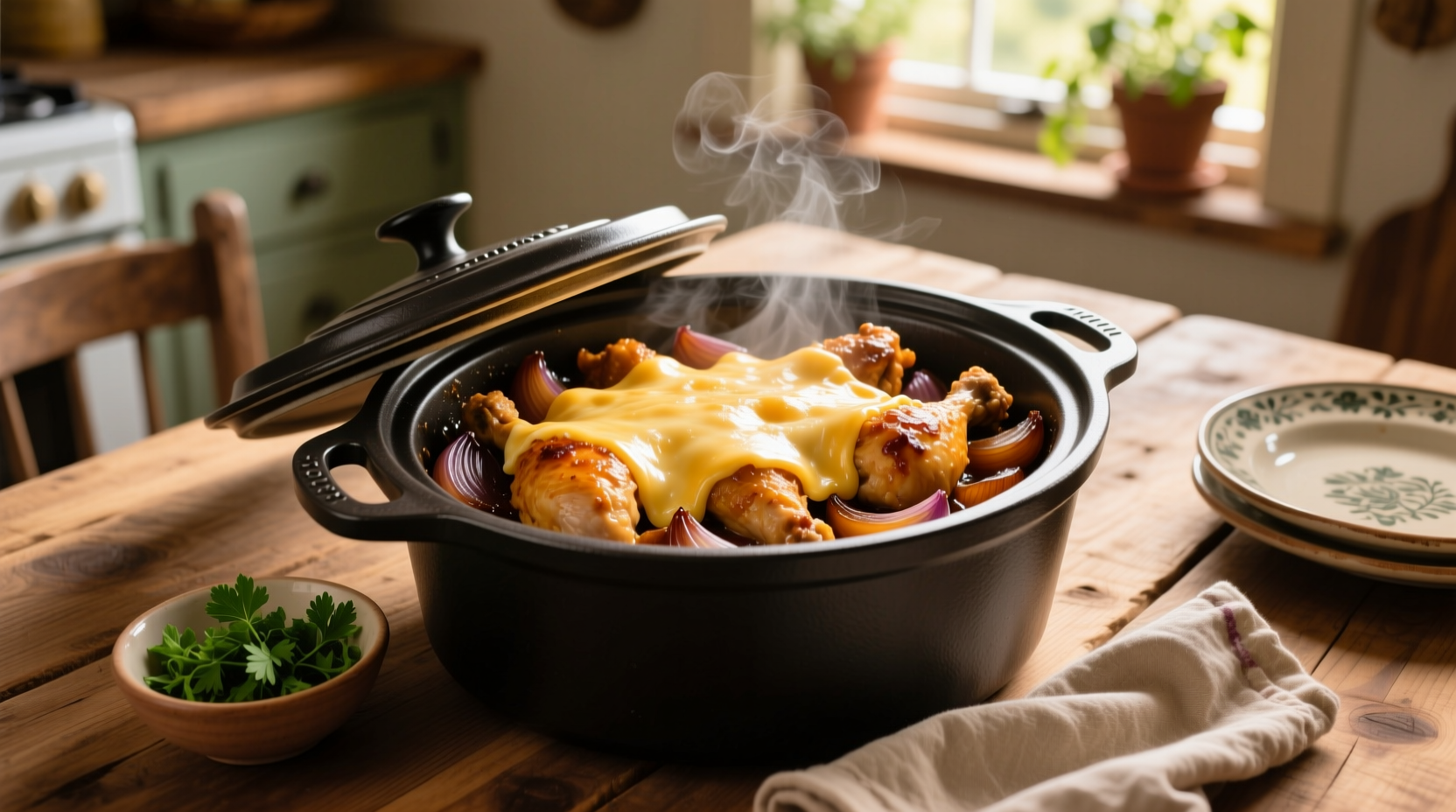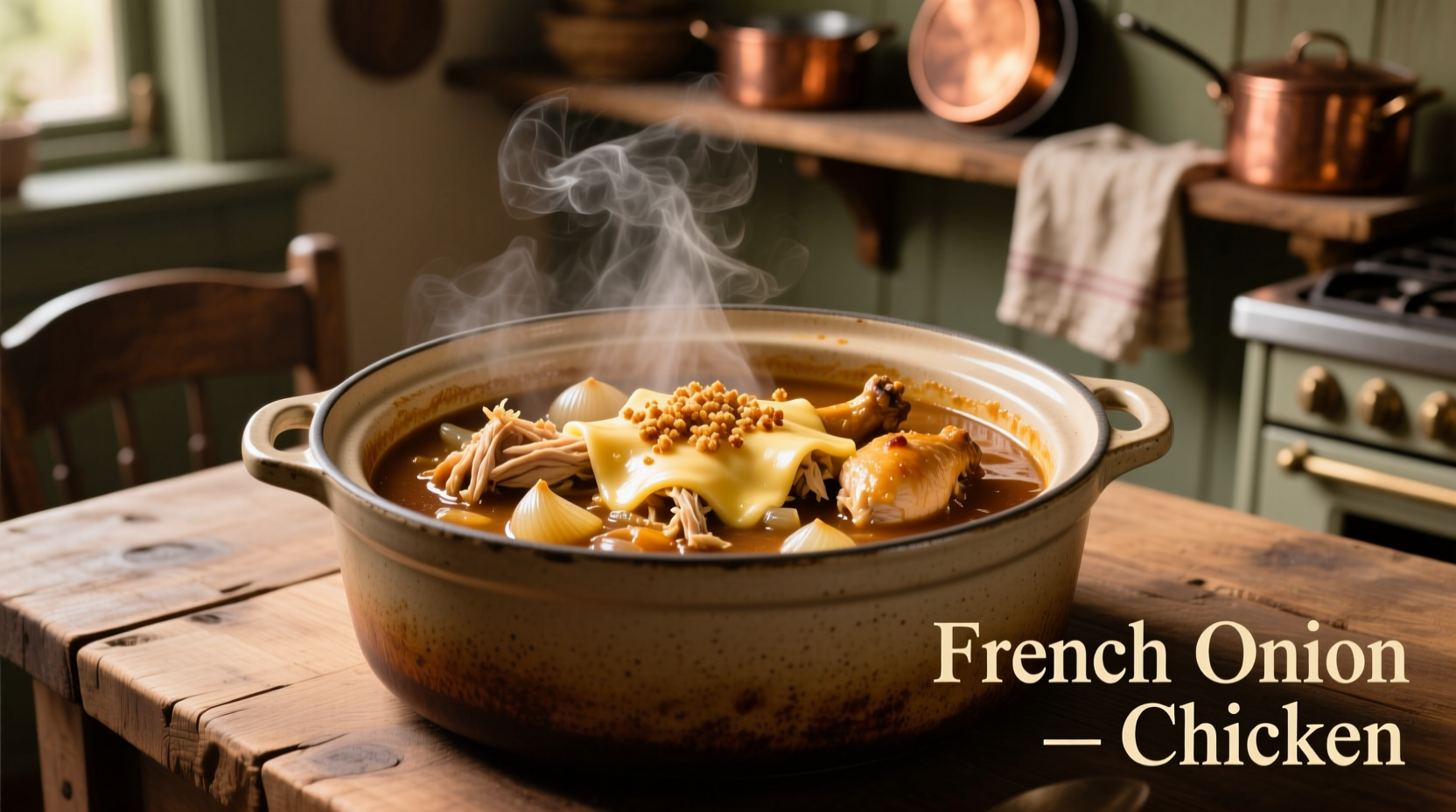Why This Slow Cooker French Onion Chicken Recipe Works
French onion chicken transforms beautifully in a slow cooker, allowing flavors to meld while keeping the chicken incredibly moist. Unlike stovetop versions that require constant attention, this hands-off method delivers consistent results with minimal effort. The slow cooking process develops deep, complex flavors as the onions caramelize gradually, creating a rich sauce that penetrates the chicken completely.

Your Complete Ingredient Guide
Quality ingredients make the difference between ordinary and exceptional French onion chicken. Here's what you'll need and why each component matters:
| Ingredient | Why It Matters | Substitution Options |
|---|---|---|
| 4 boneless, skinless chicken breasts | Uniform thickness ensures even cooking | Thighs work well but require 1-2 hours longer |
| 3 large yellow onions, thinly sliced | Yellow onions provide ideal balance of sweetness and pungency | Red onions add color but are more pungent |
| 1 cup beef broth | Creates rich base without overpowering chicken | Chicken broth works but yields milder flavor |
| 1/2 cup dry white wine | Acidity balances richness and enhances onion flavor | Apple cider vinegar (2 tbsp) + water (6 tbsp) |
Step-by-Step Cooking Process
Follow these precise steps for perfect French onion chicken every time:
Preparation Phase (10 minutes)
- Slice onions uniformly (1/8 inch thick) for even caramelization
- Dry chicken thoroughly with paper towels to ensure proper searing
- Season chicken generously with salt and pepper on both sides
Cooking Sequence (6-7 hours)
- Layer half the onions in the bottom of your crock pot
- Place chicken on top of onions in a single layer
- Add remaining onions over chicken
- Pour broth and wine evenly over everything
- Cook on LOW for 6 hours (or HIGH for 3-4 hours)
- Optional: Add 1/2 cup shredded Gruyère cheese during last 30 minutes
Timing and Temperature Guidelines
Understanding cooking times prevents dry chicken and underdeveloped flavors. This timeline shows exactly what happens during slow cooking:
| Cooking Time | What's Happening | Visual Cues |
|---|---|---|
| 0-2 hours | Onions release moisture, creating steam environment | Liquid visible in pot, onions beginning to soften |
| 2-4 hours | Onions caramelize slowly, flavors intensify | Onions turn golden, liquid reduces slightly |
| 4-6 hours | Chicken becomes fork-tender, absorbs flavors | Chicken shreds easily, internal temperature 165°F |
When Slow Cooker French Onion Chicken Works Best
This method excels in specific situations but has limitations. Understanding these context boundaries ensures perfect results:
- Ideal for meal prep: Flavors improve when stored and reheated, making it perfect for weekly cooking
- Best with boneless cuts: Bone-in chicken requires significant timing adjustments and may overcook
- Not for quick meals: Requires minimum 3 hours on high setting for proper flavor development
- Altitude considerations: Above 3,000 feet, add 30-60 minutes cooking time due to lower boiling point
Serving Suggestions and Variations
Elevate your French onion chicken with these professional pairing recommendations:
Classic Pairings
- Mashed potatoes (the sauce soaks in perfectly)
- Buttered egg noodles with fresh parsley
- Crusty baguette for dipping in the rich sauce
Dietary Modifications
- Gluten-free: Use tamari instead of soy sauce in the optional sauce enhancement
- Lower sodium: Substitute low-sodium broth and omit added salt
- Creamier version: Stir in 1/4 cup sour cream during last 30 minutes
Storage and Reheating Instructions
Proper storage maintains quality for future meals:
- Refrigeration: Store in airtight container for up to 4 days
- Freezing: Freeze for up to 3 months (thaw overnight in refrigerator)
- Best reheating method: Gently warm in saucepan over medium-low heat, adding small amounts of broth if needed
- Microwave option: Cover and heat in 90-second intervals, stirring between
Troubleshooting Common Issues
Fix these frequent problems before they ruin your meal:
- Watery sauce: Remove chicken, set crock pot to HIGH, and cook uncovered for 30-60 minutes to reduce
- Dry chicken: Usually caused by overcooking - stick to recommended times
- Bland flavor: Add 1 tsp Worcestershire sauce and 1/2 tsp Dijon mustard to enhance depth
- Burnt bottom: Ensure onions are properly layered and not touching heating element directly
Frequently Asked Questions
Can I use frozen chicken in this crock pot French onion chicken recipe?
Yes, but add 1-2 hours to cooking time. Never place completely frozen chicken directly in the slow cooker as it creates food safety concerns. Thaw partially in the refrigerator first for best results and food safety.
How do I prevent the onions from burning at the bottom of the crock pot?
Layer half the onions on the bottom first, then add chicken, then the remaining onions. This creates a protective barrier between the heating element and onions. Stirring once at the 2-hour mark also prevents sticking without disrupting the cooking process.
What's the difference between using beef broth versus chicken broth in French onion chicken?
Beef broth creates a richer, more traditional French onion soup flavor profile that complements the caramelized onions. Chicken broth yields a lighter, more delicate sauce that lets the chicken flavor shine through. For best results, use low-sodium broth to control salt levels.
Can I make this recipe without alcohol?
Absolutely. Substitute the wine with additional broth plus 1 tablespoon of apple cider vinegar or lemon juice to maintain the necessary acidity that balances the richness of the dish. The vinegar provides the bright note that wine normally contributes.











 浙公网安备
33010002000092号
浙公网安备
33010002000092号 浙B2-20120091-4
浙B2-20120091-4